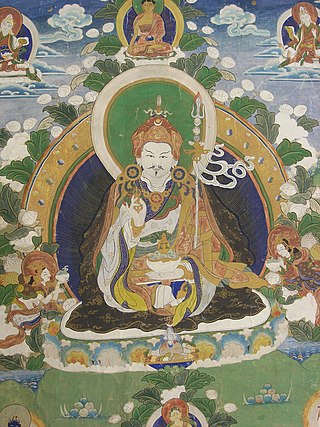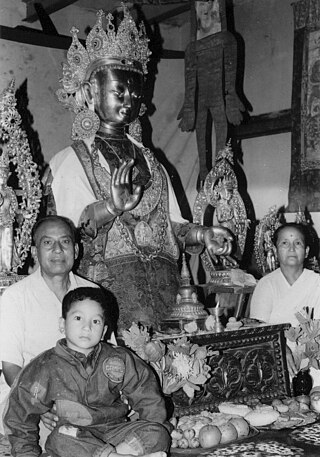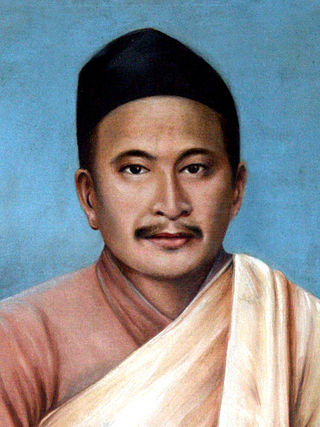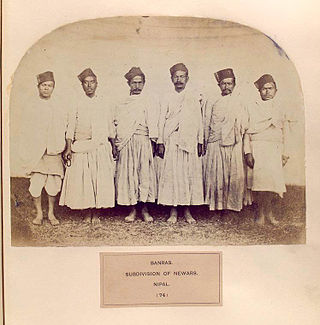
Newar or Nepami, are the historical inhabitants of the Kathmandu Valley and its surrounding areas in Nepal and the creators of its historic heritage and civilisation. Newars form a linguistic and cultural community of primarily Indo-Aryan and Tibeto-Burman ethnicities following Hinduism and Buddhism with Nepal Bhasa as their common language. Newars have developed a division of labour and a sophisticated urban civilisation not seen elsewhere in the Himalayan foothills. Newars have continued their age-old traditions and practices and pride themselves as the true custodians of the religion, culture and civilisation of Nepal. Newars are known for their contributions to culture, art and literature, trade, agriculture and cuisine. Today, they consistently rank as the most economically and socially advanced community in Nepal, according to the annual Human Development Index published by UNDP. Newars are ranked the 8th largest ethnic group in Nepal according to the 2021 Nepal census numbering 1,341,363 people constituting 4.6% of the total population.
Buddhism in Nepal started spreading since the reign of Ashoka through Indian and Tibetan missionaries. The Kiratas were the first people in Nepal who embraced Gautama Buddha’s teachings, followed by the Licchavis and Newar people. Buddha was born in Lumbini in the Shakya Kingdom. Lumbini lies in present-day Rupandehi District, Lumbini zone of Nepal. Buddhism is the second-largest religion in Nepal. According to 2001 census, 10.74% of Nepal's population practiced Buddhism, consisting mainly of Tibeto-Burman-speaking ethnicities and the Newar. However, in the 2011 census, Buddhists made up just 9% of the country's population.

A vajrācārya is a Vajrayana Buddhist master, guru or priest. It is a general term for a tantric master in Vajrayana Buddhist traditions, including Tibetan Buddhism, Shingon, Bhutanese Buddhism, Newar Buddhism.

Gunlā is the tenth month in the Nepal Sambat lunar calendar, the national lunar calendar of Nepal. It corresponds to August of the Gregorian Calendar.

Newar caste system is the system by which Newārs, the historical inhabitants of Kathmandu Valley, are divided into groups on the basis of Vedic varna model and divided according to their hereditary occupations. First introduced at the time of the Licchavis, the Newar caste system assumed its present shape during the medieval Malla period. The Newar caste structure resembles more closely to North India and Madheshis than that of the Khas 'Parbatiyas' in that all four Varna and untouchables are represented. The social structure of Newars is unique as it is the last remaining example of a pre-Islamic North Indic civilisation in which Buddhist elements enjoy equal status with the Brahmanic elements.

Tulādhar is a Nepali/Nepalese caste from the Newar community of the Kathmandu Valley in Nepal. The name Tuladhar is derived from the Sanskrit words "tula" and "dhar" (possessor), thus meaning scale-bearer or in general, merchant. Tuladhars belong to the Uray group which includes Kansakar, Tamrakar, Sthapit, Bania, Sindurakar, Selalik and other castes. They follow Newar Buddhism and speak Nepal Bhasa as a mother tongue.

Asan is a ceremonial, market and residential square in central Kathmandu, the capital of Nepal. It is one of the most well-known historical locations in the city and is famed for its bazaar, festival calendar and strategic location. Asan has been described as a fine Newar example of a traditional Asian bazaar. The Tuladhar, Maharjan, Shrestha, Bajracharya and Shakya castes make up most of the population.

Dharma Man Tuladhar was a Nepalese trader and philanthropist best known for the renovation of the Swayambhu stupa in Kathmandu, one of the holiest Buddhist shrines in Nepal.

Nisthananda Bajracharya was a Nepalese writer who marked a turning point in Nepal Bhasa literature by breaking away from the classical style and writing prose in colloquial language. He was one of the leaders of the Nepal Bhasa renaissance, and also a pioneer of printing with moveable type in Nepal. He is honored as one of the Four Pillars of Nepal Bhasa.

Newari Banias are a Bania caste from the Newar community of the Kathmandu Valley in Nepal. The name Bania is derived from the Sanskrit word vanijya (merchant); by preference, Bania (caste).

Gunlā Bājan is Buddhist devotional music played by the Newars of Nepal. "Gunla" is the name of the tenth month in the Nepal Sambat calendar, which corresponds to August in the Gregorian calendar and "bajan" means "music" and "music playing group".

Kansakār or Kasāh (कसाः) is a Nepalese caste group belonging to the Newar community of the Kathmandu Valley in Nepal. In Sanskrit, Kansakar means bronze worker, and their traditional occupation has been metal working and trading. Today, they are merchants, industrialists and professionals.

Pragyananda Mahasthavir was a Nepalese Buddhist monk who was one of the leaders of the revival of Theravada Buddhism in Nepal. In 1930, he became the first monk wearing yellow robes to be seen in Kathmandu since the 14th century.

Bauddha Rishi Mahapragya was one of the most influential figures in the revival of Theravada Buddhism in Nepal in the 1920s. In 1926, he was jailed and then exiled by the tyrannical Rana regime for converting to Buddhism from Hinduism.

Urāy is a Newar Buddhist merchant caste of Kathmandu in Nepal. They are a prominent community in the business and cultural life of Kathmandu. Urays have played key roles in the development of trade, industry, art, architecture, literature and Buddhism in Nepal and the Himalayan region.

Sthāpit is a Nepalese caste from the Newa people of the Kathmandu Valley in Nepal. Sthapits are part of the Uray group which includes Tuladhar, Kansakar, Tamrakar, Bania, Sindurakar, Selalik Kasthakar and other castes. Their religion is Newar Buddhism and their mother tongue is Nepal Bhasa.

Samyak is an almsgiving Buddhist festival celebrated in the Kathmandu Valley in Nepal. During the ceremony which is held on a large open ground, hundreds of Dīpankara Buddha images are assembled, and gifts of different types of food are made to the Buddha images and the Buddhist community.

Jana Bahā Dyaḥ Jātrā is the chariot procession of Jana Baha Dyah, the Bodhisattva of Compassion, which is held annually in Kathmandu. It begins on the 8th day and ends on the 10th day of the bright fortnight of Chaulā (चौला), the sixth month in the lunar Nepal Era calendar.

The banishment of Buddhist monks from Nepal was part of a campaign by the Rana government to suppress the resurgence of Theravada Buddhism in Nepal in the early the 20th century. There were two deportations of monks from Kathmandu, in 1926 and 1944.

Jana Bahal, often called Janabahaa: and also called Machindra Bahal and less frequently Kanak Chaitya Mahavihar, is one of the few Bahal which have fully fledged storied temple standing in the middle of a court. The main deity residing in the temple is the Seto Machindranath also known as Janabaha Dyo, Aryavalokitesvara and Karunamaya.






















